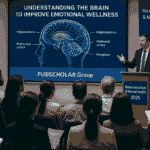In today’s high-pressure world, anxiety can manifest in many ways, but few conditions are as paralyzing as panic disorder. Imagine feeling a sudden, overwhelming surge of fear, your heart pounding, breath shortened, chest tightening, and a crushing sense that something terrible is about to happen, without any real threat. That is the reality for millions of individuals worldwide suffering from this condition.
More than just occasional worry or fear, this disease is a serious mental health condition characterized by recurrent, unexpected panic attacks. These episodes can strike without warning and leave lasting emotional scars, often leading sufferers to avoid places, situations, or even daily responsibilities for fear of another attack. The cycle becomes self-reinforcing; fear of a panic attack triggers more anxiety, creating a loop that can seem impossible to escape.
But there’s hope. Today, through innovative research and dedicated panic disorder clinical trials, healthcare professionals are making significant strides toward better understanding, treating, and eventually breaking the cycle of this condition. From novel medications to cognitive therapies and lifestyle interventions, science is opening new doors to recovery.
This blog explores the causes, symptoms, treatments, management strategies, and the powerful role of clinical trials in transforming the way we view and treat this condition.
Prevalence
According to the National Institute of Mental Health (NIMH), approximately 2.7% of U.S. adults experience this disorder each year. It is more common in women than men, typically developing in late adolescence or early adulthood. Globally, the World Health Organization (WHO) estimates that about 264 million people are affected by anxiety disorders, with panic disorder contributing a considerable proportion of those cases.
What is particularly concerning is that many people suffering from this disease remain undiagnosed due to stigma, lack of access to mental health care, or misunderstanding of the symptoms. The economic and social burdens are significant, leading to workplace disruptions, impaired relationships, and reduced quality of life.
This widespread impact makes the work being done in panic disorder clinical trials not just promising, but essential. By participating in or supporting these studies, we contribute to better treatments and improved lives.
Understanding Panic Disorder
Panic Disorder is an anxiety disorder marked by sudden and repeated attacks of intense fear that last for several minutes or longer. These episodes, known as panic attacks, can strike without warning and are often unpredictable and debilitating. Unlike ordinary anxiety that arises from a specific stressor, panic attacks may occur in calm or neutral situations, leaving individuals feeling helpless and confused. During an attack, a person may experience an overwhelming sense of doom, detachment from reality, or fear of dying.
Culprits Behind Disorder
The exact cause remains unclear, but several contributing factors have been identified:
|
Causes |
Description |
|
Genetics |
Family history can increase the likelihood of developing panic disorder. |
|
Biological Factors |
Neurochemical imbalances in the brain, especially serotonin and norepinephrine. |
|
Stressful Life Events |
Trauma, abuse, or major life changes like divorce or job loss. |
|
Temperament |
A tendency to experience negative emotions or sensitivity to stress. |
|
Health Conditions |
Thyroid problems, heart issues, or respiratory conditions can mimic panic symptoms. |
Signs & Symptoms
Panic disorder presents both physical and emotional symptoms. A panic attack typically peaks within 10 minutes and can feel life-threatening.
|
Symptoms |
Explanation |
|
Rapid Heartbeat |
A racing heart that may mimic a heart attack. |
|
Shortness of Breath |
Difficulty breathing or feeling smothered. |
|
Chest Pain |
Tightness or sharp pain, often misinterpreted as a cardiac event. |
|
Dizziness or Lightheadedness |
Feeling faint, shaky, or off balance. |
|
Sweating or Chills |
Sudden temperature changes in the body. |
|
Nausea or Stomach Upset |
Discomfort or pain in the stomach. |
|
Fear of Losing Control |
Intense dread or fear of going crazy or dying. |
|
Detachment from Reality |
A feeling of unreality or being outside one’s body. |
Available Treatment Options
A multi-faceted approach is most effective in managing this condition. Here is a breakdown of standard treatments:
|
Treatment |
Details |
|
Psychotherapy |
Cognitive Behavioral Therapy (CBT) is highly effective in treating panic disorder. |
|
Medications |
SSRIs (e.g., fluoxetine), benzodiazepines (e.g., lorazepam), SNRIs, and beta-blockers. |
|
Lifestyle Changes |
Regular exercise, mindfulness, breathing exercises, and sleep hygiene. |
|
Alternative Therapies |
Yoga, acupuncture, and herbal remedies (under supervision). |
Clinical Trials: Driving the Future of Treatment
One of the most exciting developments in mental health research is the surge of panic disorder clinical trials that focuses on innovative treatments. These trials play a critical role in advancing our understanding and improving existing therapies.
Current Focus Areas in Clinical Trials
- Novel medications with fewer side effects.
- Digital CBT platforms for remote, personalized therapy.
- Neurostimulation techniques like transcranial magnetic stimulation (TMS).
- Biomarker identification to predict who may benefit from certain treatments.
For example, some studies are exploring the use of psychedelic-assisted therapy for treatment-resistant disorders, showing early but promising results.
Participating in a panic disorder clinical trial not only offers patients access to innovative treatments but also contributes to the future of mental healthcare.
Management Strategies
Managing this disorder requires a holistic and consistent approach. Here are strategies that can support day-to-day well-being:
- Therapy Engagement
Regular sessions with a licensed mental health professional can help address underlying issues and develop coping mechanisms.
- Mindfulness and Meditation
These practices reduce the brain’s reactivity to panic triggers and improve emotional regulation.
- Structured Exercise
Cardiovascular activity releases endorphins and reduces stress hormone levels.
- Breathing Techniques
Deep, controlled breathing can interrupt a panic attack and calm the nervous system.
- Avoidance of Triggers
Reducing caffeine, alcohol, and stimulants can significantly help those with panic disorder.
- Social Support
Talking with friends, family, or support groups can alleviate feelings of isolation.
Why Timely Diagnosis and Treatment Matter
Delaying treatment for this condition can lead to the development of agoraphobia, substance misuse, depression, and other anxiety-related disorders. Moreover, untreated panic disorder can severely hinder an individual’s ability to work, study, or maintain relationships.
Final Thoughts
Panic disorder is not a life sentence. With the right treatment and support, it is entirely manageable, and even curable in many cases. As science advances and mental health becomes less stigmatized, we are witnessing a revolution in how we approach conditions like this disorder.
Panic disorder clinical trials are vital in this transformation. They bring together researchers, patients, and healthcare providers in a shared mission: to break the cycle of fear, uncertainty, and isolation. Whether you are struggling with symptoms or looking for a way to contribute to mental health progress, exploring a clinical trial may be a powerful step forward.
- Breaking the Cycle: How Clinical Trials are Addressing Panic Disorder
- Learn about panic disorder symptoms, causes, treatments, and the crucial role of clinical trials in advancing mental health care and recovery options.
- Panic Disorder, Anxiety Disorders, Clinical Trials for panic disorder
Related posts:
 The Rise of the Probiotic Drink: A Wellness Staple for Gut and Liver Health
The Rise of the Probiotic Drink: A Wellness Staple for Gut and Liver Health
 How the Neurology and Mental Health Conference 2025 Empowers Patients
How the Neurology and Mental Health Conference 2025 Empowers Patients
 Dentist in Largo Florida – Expert Care with a Personal Touch at Blue Dental Largo
Dentist in Largo Florida – Expert Care with a Personal Touch at Blue Dental Largo
 Shop Premium Ayurvedic Sexual Capsules Online from Trusted Brands
Shop Premium Ayurvedic Sexual Capsules Online from Trusted Brands
 Benefits of Choosing Full Body Laser Hair Removal Treatment for Unwanted Hair Removal
Benefits of Choosing Full Body Laser Hair Removal Treatment for Unwanted Hair Removal
 Discover the Ultimate Relaxation with Swedish Massage Therapy: A Path to Healing and Renewal
Discover the Ultimate Relaxation with Swedish Massage Therapy: A Path to Healing and Renewal
 Be Energized Naturally with best Oral Therapy at Home in Dubai
Be Energized Naturally with best Oral Therapy at Home in Dubai
 Real People Share How Laser Treatment Costs Changed Their Look
Real People Share How Laser Treatment Costs Changed Their Look







